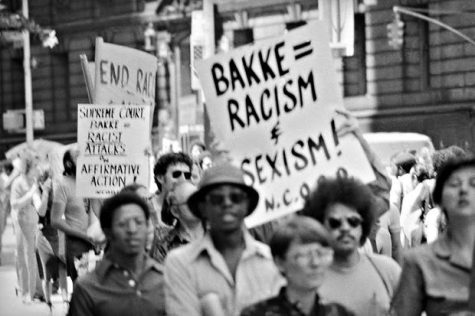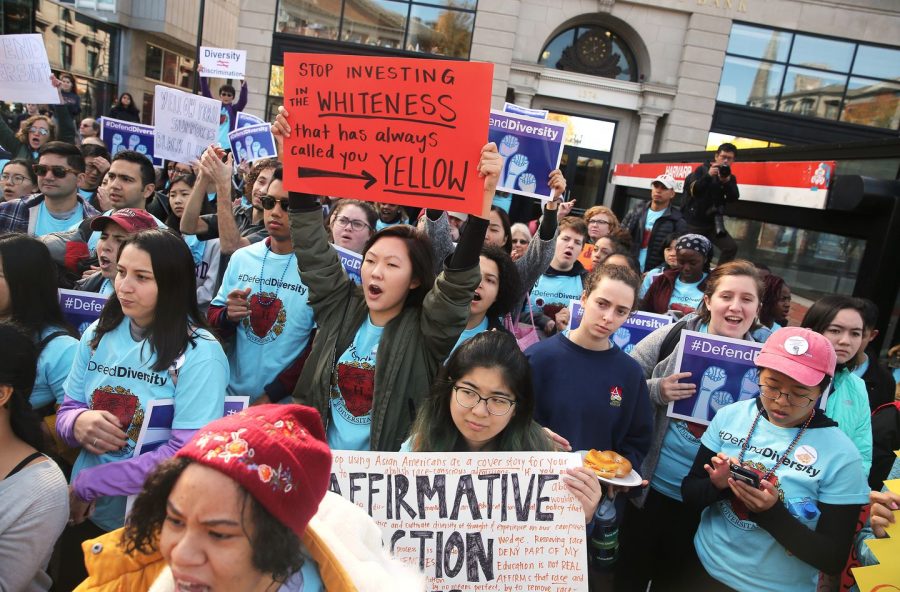Should We Get Rid of Affirmative Action?
Since 1961, affirmative action has been used by colleges and universities to promote advantages for minority groups when applying to schools. Affirmative action is defined as an active effort to improve the employment or educational opportunities of members of minority groups and women. It was first introduced by JFK in an executive order for government contractors to take “affirmative action.”
Affirmative action is often criticized as “reverse discrimination,” with evidence suggesting that it both violates the Fourteenth Amendment equal protection clause, and allows for even more discrimination against certain minorities. Is it even appropriate for co

Demonstrators from an organization calling itself Anti-Bakke Decision Coalition carry signs as they march before the federal court house in Foley Square in New York, June 30, 1978.
lleges and universities to use race as a component in the application process? Though it is intended to help minority groups, it discriminates against some of them and it does not abide by the merit system. On the other hand, affirmative action allows for schools to diversify themselves.
In 2003, voters in Michigan passed a ban on the use of affirmative action in the public arena. Two other states, California and Washington, have done similar things to reduce the use of affirmative action. In 1978, there was a Supreme Court case involving the University of California medical school and a white man, Allan Bakke, who was denied admittance twice to the university. Bakke took this to the courts, arguing that he was unconstitutionally denied admittance due to affirmative action. The University was withholding sixteen spots of the hundred available, for minorities. Whereas Bakke received a grade point average (GPA) of 3.46, the sixteen minorities all received GPAs of around 2.88. Despite this, they got in and Bakke did not. Bakke sued, alleging that this decision violated the Fourteenth Amendment, and that affirmative action had wrongfully discriminated against him. The courts ruled that it is unlawful to withhold a specific number of spots for minorities, but that affirmative action is allowed sometimes.
More recently, in 2018, the Supreme Court heard a case brought by Asian-Americans who believed that they had been discriminated against when they applied to Harvard University. They alleged that Harvard held Asian-Americans to a higher standard than other races, saying that this double standard violated their civil rights. Attorney Adam K. Mortora, graduate and lecturer at Chicago University Law School, argued that “Harvard has engaged in, and continues to engage in, intentional discrimination against Asian Americans,” using statistical analyses to show that Harvard repeatedly gave Asian-Americans lower ratings when reviewing their applications.
While affirmative action benefits some minorities, it ironically causes others to be discriminated against. Schools should not take race into consideration because it will always lead to some discrimination. By removing the requirement of race on applications, people will be chosen based on merit more, as well as keep schools economically diverse.
Sources:
“Affirmative Action.” Wikipedia, Wikimedia Foundation, 7 March 2020.
Anderson, Nick. “Harvard Admissions Trial Opens with University Accused of Bias against Asian Americans.” The Washington Post, WP Company, 15 October 2018.
“Regents of the Univ. of Cal. v. Bakke.” Wikipedia, Wikimedia Foundation, 3 March 2020.
Shapira, Ian. “Before Asian Americans Sued Harvard, the School Once Tried Restricting the Number of Jews.” The Washington Post, WP Company, 15 October 2018.
Addie is a freshman at BASIS Independent Brooklyn. In her free time, she enjoys running, tennis, reading, and hanging out with her friends. She is excited...







